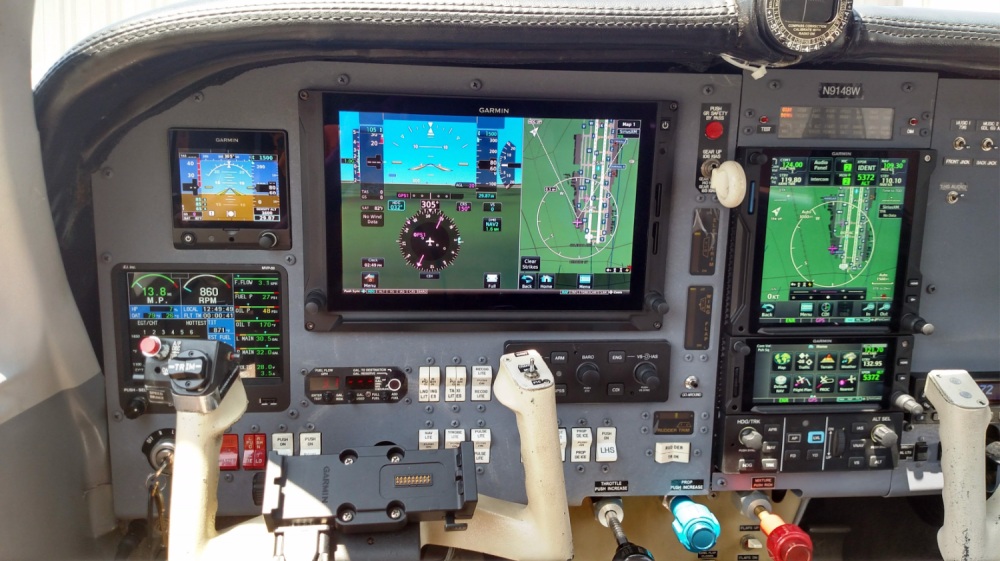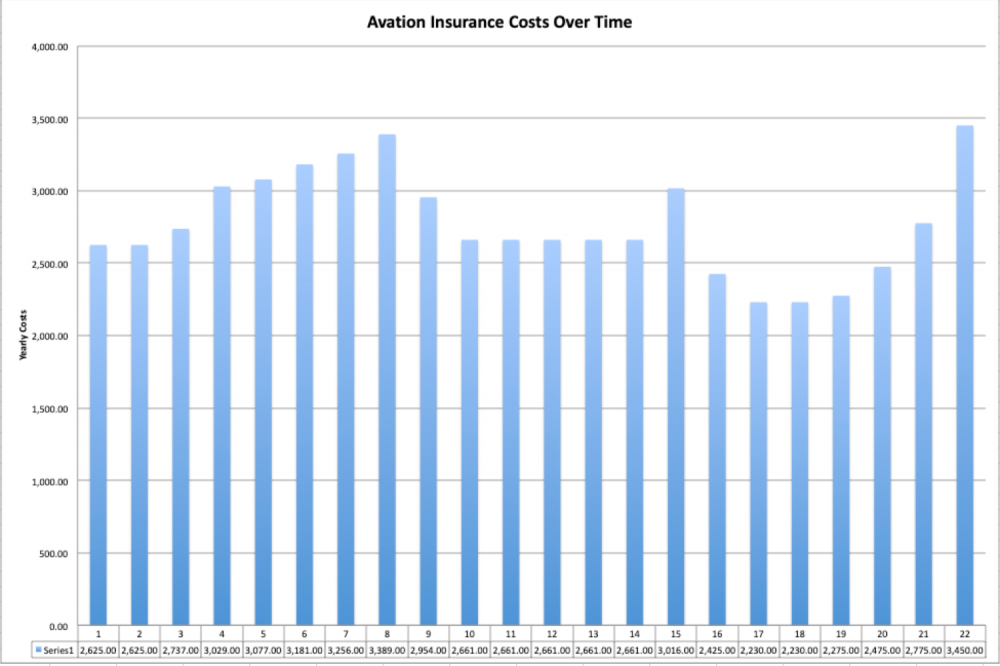-
Posts
2,616 -
Joined
-
Last visited
-
Days Won
33
Everything posted by donkaye
-

When things start getting complicated ...
donkaye replied to donkaye's topic in Miscellaneous Aviation Talk
Well, obviously you're the expert here, however, looking at the Airport Chart and actually being there are two different things regarding this airport. Taxiway L is short and not well marked among one mass of asphalt. As mentioned, there are hotspots to contend with, any one of which could get you violated if you should screw up. In the interest of both safety and time, I unhesitatingly took the easy way out with a Progressive Taxi. -
While I suppose you could do that, what is an A&P going to be able to do in flight? It's pretty obvious when recording all the parameters if there is an anomaly. I circle the airport up to 4,000 feet, then set up a holding pattern on the Aera 760 or, if a GTN 750 is available, do it on the 750 and fly the hold a couple of miles to the side of the runway. If there were to be an issue, just circle down and land. I have done all my break-ins with flight following in combination with traffic and weather on the above avionics. The spreadsheet goes to the Shop after I land.
-
That's the one I had installed a few months ago to replace a BK trim switch. It is PMA'd per the attached file. Check for applicability.
-
-
Today at KCCR: Me: Good Afternoon Concord Ground, Mooney 9148W, Sterling, ready to taxi with Bravo. Ground: 9148W Concord Ground, taxi to Runway 19R via Lima, Alpha, Cross 32L, Cross 32R via Alpha. This was said in rapid fire ATC speak. Me, not wanting to embarrass myself: Ground, tell you what, request Progressive to 19R Turns out Lima is striped but part of the non movement area and not well marked. If you fly out of there, it's all not much of a problem, but if you haven't, you could easily screw it up. It had been quite a while since I had flown into Concord. In the interest of saving time and not screwing up, Progressive taxiing took off all the pressure. I needed to fly back there later in the day. The second time I had everything written down, and Progressive wasn't necessary.
-
I've attached the Service Alert to the GTN Xi and GTN updates last December. Look at what the Xi can do that the legacy GTN cannot. Since that time Garmin added Smart Glide that the legacy GTN doesn't have the processing power to do. So you're paying for those upgrades and those future upgrades that we don't know about, yet. Getting at the databases for updates is also easier with the Xi. GTN Xi Main Software Version 20.10 and GTN 6XX:7XX Main Software Version 6.71 - Aviation Alerts and .pdf
-
I've done numerous engine break-ins. I follow the Lycoming Directions contained in the attached Service Instructions. I've also attached an example Spreadsheet I use and fill out during the flight. It certainly helps to have an autopilot during the break-in. Engine Breakin N9148W 1.xlsx Lycoming Reciprocating engine Break-In and Oil Consumption.pdf
-
Yes, I needed to fly to Aurora, Oregon for the upgrade. They did the upgrade in a couple of hours including configuration setting, and I flew back the same day.
-
If you have a GTN 750Xi, a GI275, and a GFC 500 you have autopilot control of the smart glide all the way to the center of the chosen airport. If you have a GTN 750Xi, a G5, and a GFC 500, a software update to the G5 is required for AP control, and that isn't expected until the 4th quarter of this year. If you don't have a GFC 500, you can fly the smart glide yourself, but won't have AP control of it.
-
I had mine upgraded by Pacific Coast Avionics in Oregon last year. They took my older units in trade. The trade was comparable to that of Sarasota Avionics' offer last year. I personally would recommend the upgrade. All new software upgrades are not necessarily backwards compatible with the older units. For example, the new Smart Glide is only available on the Xi units. I expect other upgrades to become available only for the Xi units that have more processing power. Having a good justification often works in upgrades. My justification last year was that, since Oshkosh didn't happen, I really wasn't losing any money by just transferring the money that would have been spent on Oshkosh 2020 to the cost of the upgrades.
-
The Garmin EIS was not available when I did my upgrade, however, I wouldn't have bought it if it had been available. The MVP-50 provides so much more data with its multiple pages, and for me one of the most important data pieces is the extra register that provides for fuel used on each trip, which resets on shutdown, in addition to the register that keeps track of fuel used since fuel addition. This allows me to travel to a student and, without any mental computations, know exactly how much fuel it took to get there. And there are so many other important setting, like keeping track of the hottest EGT and CHT without having to look at all of them for that determination, and the ability to show an engine diagram with the EGT and CHT beside each cylinder for easy monitoring, and, of course, the ability to lean the engine either LOP and ROP among so many other capabilities. Actually, another big thing is the ability to read the display with large enough numbers so it isn't necessary to bring along a magnifying glass to read them like the JPI 900 or 930.
-
Going cross country, cross country, you find much better coverage with XM than ADS-B from my experience.
-
I started using Quicken in 1999, so it was fairly easy to generate the graph shown. I bought the plane in 1992, so I would have to go back and look at my corporate returns from there until 2000 to see what my early less experienced rates were.
-
Even if inflation adjusted, it has definitely increased over the past 4 years; especially this year with a 24% increase.
-
Sometimes a picture is worth a thousand words. Here is the chart of the past 22 years (including this year) of aviation insurance costs for my airplane. Currently ATP, CFII Master Instructor, 12,000 hours TT, 10,100 Mooney Time, and 6,500 Instructing.
-
Due to insurance considerations I had not had the opportunity to extensively fly the Acclaim Ultra. That changed last week when I had the opportunity to extensively wring it out over a period of 16 hours. This involved extensive cross county flying in addition to checking out overall flight characteristics. Since I was busy at the time, Mike Elliot did the initial transition training and helped get the plane from Florida to Texas where I was able to meet up with my student. I had previously trained him in his Encore and we flew it from Florida to the West Coast. In the following few years he upgraded that plane to have nearly the same equipment as mine, and we did a lot more training with it. Since I had a lot of confidence in his piloting skills, I was willing to do this additional training with the insurance provided by my flight insurance coverage. I have flown a lot of single engine piston airplanes, and I can easily say the Mooney Acclaim Ultra is the best of all of them. It is a shame that it was not profitable to produce. That is a real loss to the aviation community. After practicing stalling the airplane to set a standard for landing approach speeds, we were fortunate, yesterday, to have weather to be able to practice landings on runways from 11,000 feet to 2,460 feet in length and widths of 150 feet to 40 feet with crosswind components up to 17 knots. It was a piece of cake landing with full flaps and 17 knots direct crosswind. I was happy to see the ease of landing with such diversity of runways and wind. On the way from the Valley to Palo Alto, ATC cautioned to watch for traffic at your 10:00 position and that we had a 60 knot overtake speed. We watched it rapidly moving backwards. The GFC 700 autopilot is still the best of the Garmin autopilots that I have flown; smooth as silk. On the other hand, the G1000 NXi was a bit of a disappointment. We gave it a workout. It is definitely an improvement over the G1000, but it lacks some of the capability and ease of use of the G500TXi/GTN750Xi/GMA35c combination. I never could get the music input to work. It doesn't have an approach plate overlay to the moving map. It does have VSD (Vertical Display of topography) and Pathways. I found the Pathways to be annoying and now understand why it has not been added the G500 TXi. It's really a shame that all the new airplanes are forced to have the G1000s. The touch screen units are so much easier to use. All in all it was a great experience training with and flying in one great airplane.
-
Although only one data point, in over 6,500 hours of teaching I have seen exactly zero IFDs in any airplane I have done training in.
-

2007 Acclaim Type S - Fair Market Value?
donkaye replied to krb5137's topic in Modern Mooney Discussion
That airplane had an interest history. I did several transition trainings in it. When I delivered into him I had a nice tailwind and was doing 300 knots over the ground most of the way from Santa Barbara to DuPage. I remember stopping short of DuPage and staying overnight someplace when winds at DuPage were 29 gusting to 52. The air was still pretty rough for the first couple of days of the training and the Chicago temperature was bone chilling cold for this California transplant. -
Adding to my previous post, this accident was unlikely to have happened had the GFC 500 with its envelope protection and level button been installed. With the more expensive long bodies where the price to value of the airplane is relatively small, I think it makes sense to consider an autopilot upgrade a priority. For safety purposes is makes sense for all models in my opinion. With the newer autopilots with envelope protection I think spatial disorientation accidents could become a thing of the past.
-
Before upgrading my plane, I had my KI256 OH'd at least 3 times. Indication of failure was "slow to erect" time. Normally, when power was removed from it, it took time to spin down. Only once did I come out to the airplane and on power turn on found the AI upside down. What I'm saying is, unless there is a catastrophic failure of the gyro, it doesn't fail immediately, so the KFC 150 is not likely to go bonkers immediately. In this day and age and with the cost of backup attitude indicators being so inexpensive, it is not fair to both a pilot and passengers not to have an electric one installed in the aircraft.
-
The fire went out fast. Both wing parts are available and I would think the part that went through the fuselage didn't have enough time to completely burn. So the whole wing should be available to see where it failed. Given the wing was stress tested to 9½ Gs before the "jig" broke, I found it shocking to see the wings fold, if that is what happened. The main spar is an I-beam stressed for the vertical. Had it folded back that would be one thing, but to fold in the vertical where its strength is, that is something unbelievable.








